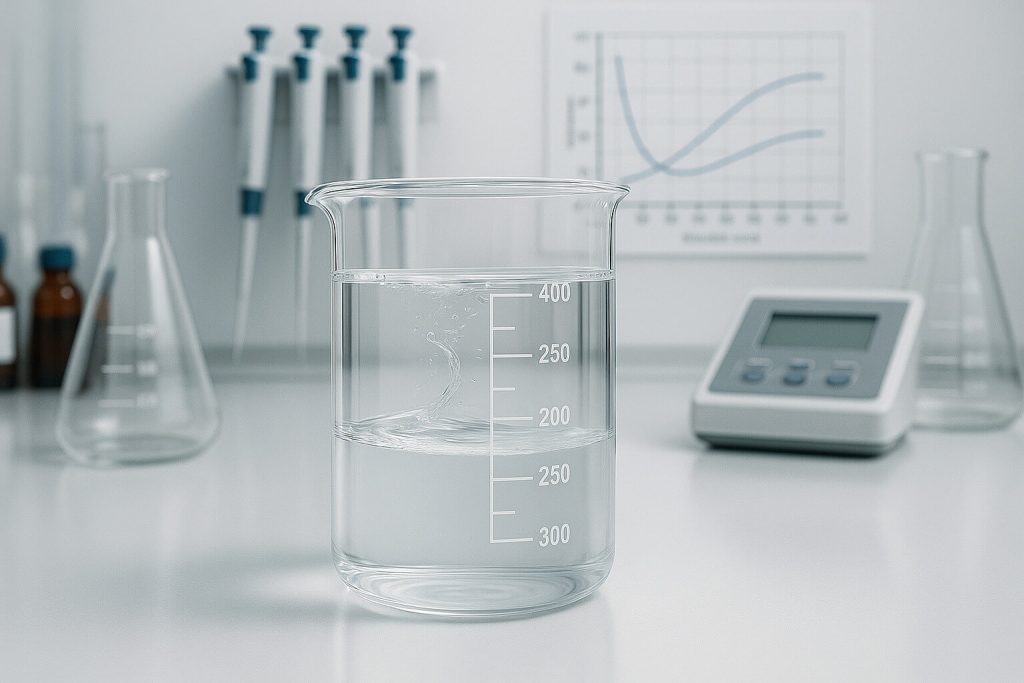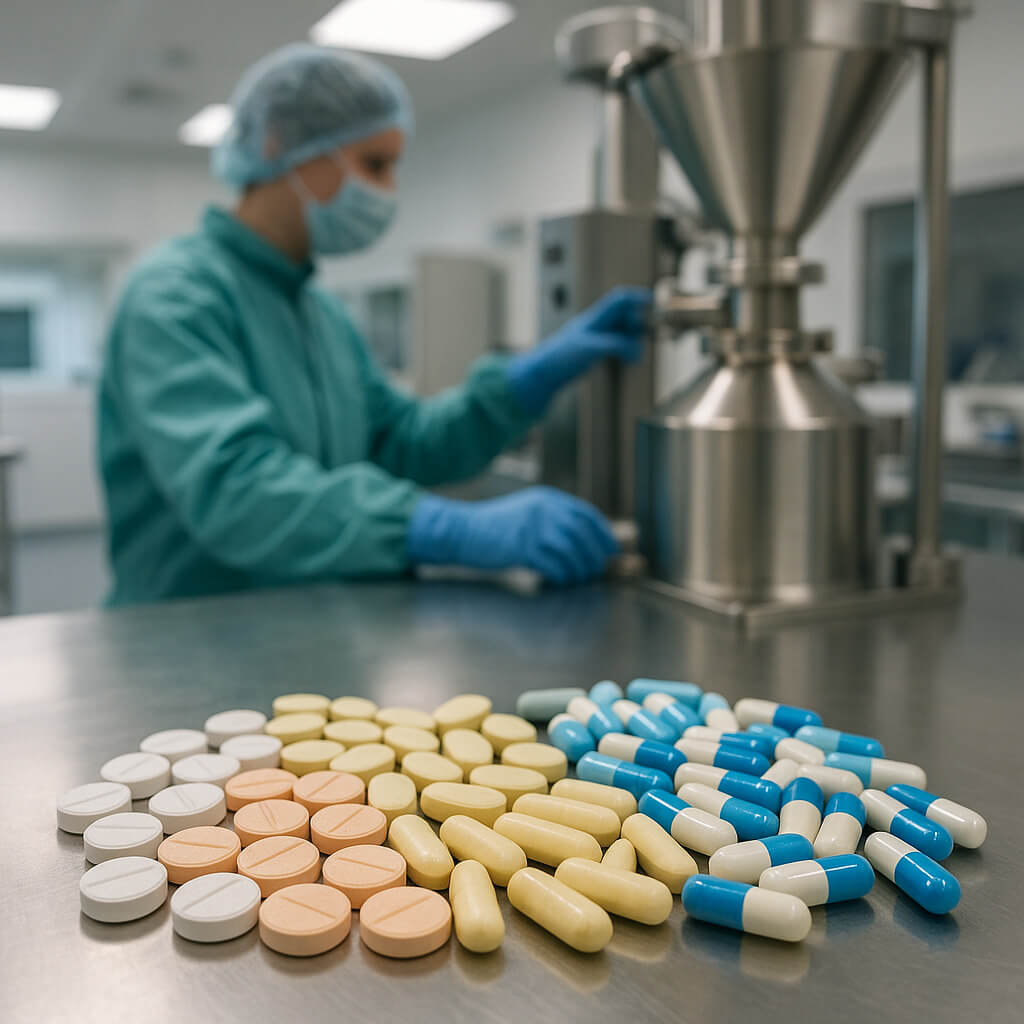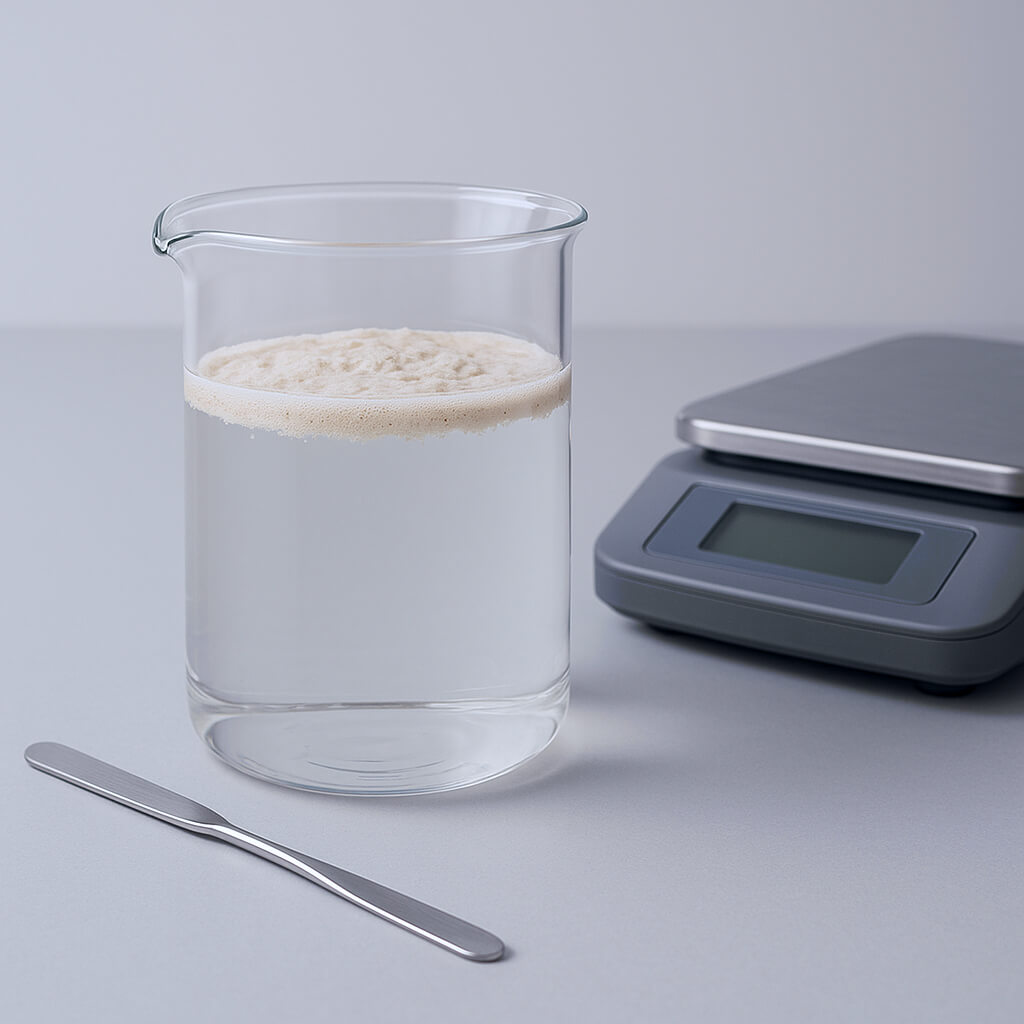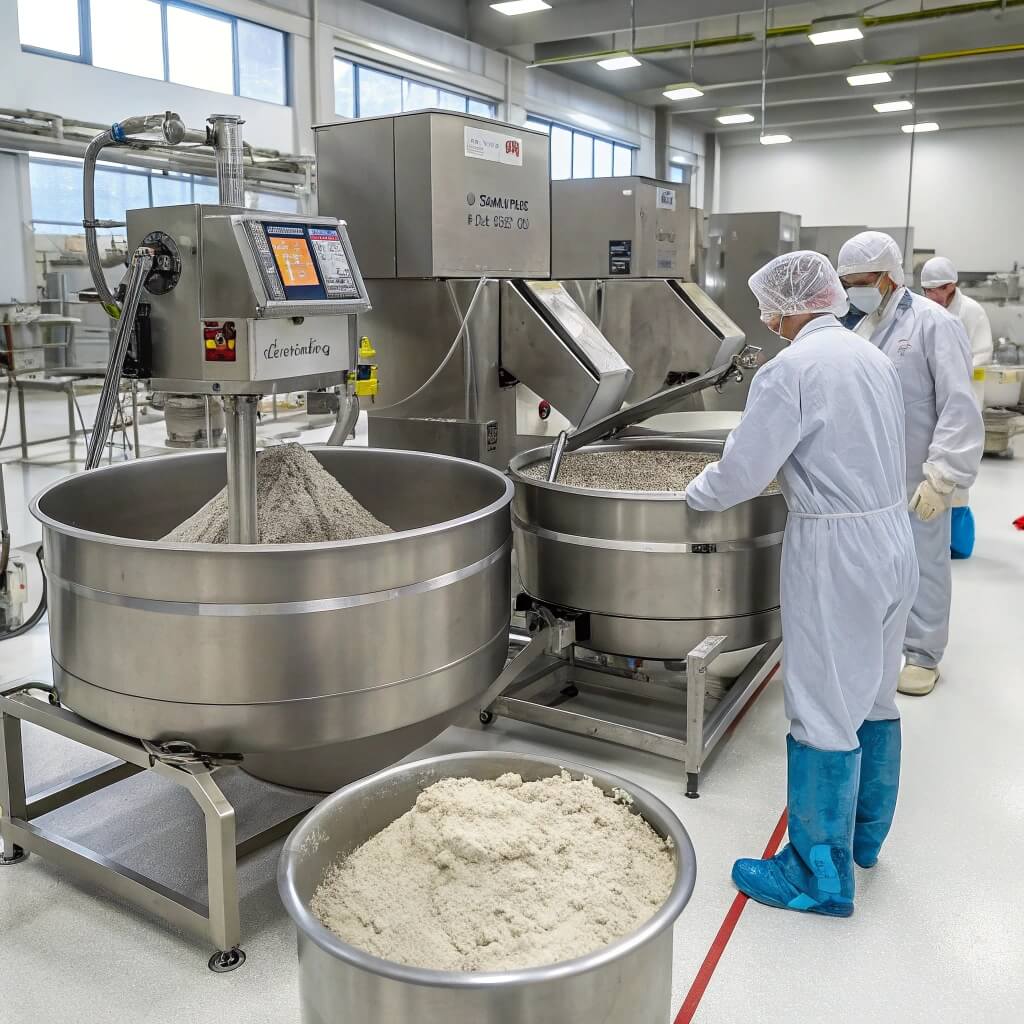هيدروكسي بروبيل ميثيل سلولوز (HPMC) هو مشتق من السليلوز، ويلعب دورًا محوريًا في العديد من الصناعات، بما في ذلك الصناعات الدوائية والبناء وإنتاج الأغذية. إن تعدد استخداماته وخصائصه الفريدة تجعله أساسيًا في مختلف التطبيقات التي تتطلب الاتساق والترابط والاستقرار. تستكشف هذه المقالة الخصائص الرئيسية لهيدروكسي بروبيل ميثيل سلولوز، وتطبيقاته في مختلف الصناعات، والفوائد الكبيرة التي يقدمها للمصنّعين. بفهم هذه الجوانب، ستتمكن من اتخاذ قرارات مدروسة بشأن استخدام هيدروكسي بروبيل ميثيل سلولوز في تركيباتك.

1. ما هو هيدروكسي بروبيل ميثيل السليلوز ولماذا هو مهم؟
هيدروكسي بروبيل ميثيل سلولوز، أو HPMC، هو بوليمر شبه صناعي قابل للذوبان في الماء، مشتق من السليلوز، وهو البوليمر الطبيعي الموجود في جدران الخلايا النباتية. يُعَدَّل بإضافة مجموعات هيدروكسي بروبيل وميثيل، مما يمنحه خصائصه الفريدة. تسمح هذه التعديلات لـ HPMC بالذوبان بسهولة في الماء وتكوين مواد هلامية، ولهذا السبب يُستخدم على نطاق واسع في مختلف الصناعات.
لماذا هذا مهم؟ بفضل قدرته على تكوين الهلام وذوبانه الممتاز، يُستخدم HPMC على نطاق واسع في التطبيقات التي تتطلب منتجًا مستقرًا ومتماسكًا. ففي مجال البناء، يُستخدم لتحسين قابلية تشكيل الخلطات الجافة، وفي الصناعات الدوائية، يُستخدم كمادة رابطة وعامل إطلاق مُتحكم به في الأقراص. وفي إنتاج الأغذية، يعمل كمُثبِّت ومستحلب ومُكثِّف، مما يضمن حفاظ المنتجات على قوامها وقوامها المطلوبين.
لا شك أن أهمية HPMC لا تُضاهى. فهي توفر مزايا وظيفية فريدة تُمكّن المصنّعين من تحسين منتجاتهم بطرق لا تُمكن البوليمرات الأخرى من تحقيقها. سواءً كان الأمر يتعلق بتحسين تدفق مواد البناء ودرجة التصاقها، أو التحكم في إطلاق الأدوية في الجسم، أو تحسين ملمس المنتجات الغذائية، فإن HPMC تُعدّ أساسيةً في توفير حلول عالية الجودة.
| صناعة | الاستخدامات الشائعة | دور HPMC |
|---|---|---|
| المستحضرات الصيدلانية | المواد الرابطة، عوامل الإطلاق المتحكم | الاتساق، وتسليم الأدوية الخاضعة للرقابة |
| بناء | الملاط والمواد اللاصقة | يحسن قابلية العمل والالتصاق والاحتفاظ بالماء |
| طعام | المستحلبات والمثبتات | يحافظ على الملمس ويمنع الانفصال |
2. ما هي الخصائص الرئيسية لهيدروكسي بروبيل ميثيل السليلوز؟
من أهم خصائص HPMC التي تجعله مفيدًا للغاية في مختلف الصناعات قابليته للذوبان في الماء، والتحكم في اللزوجة، وقدرته على تكوين الهلام، واستقراره الحراري. يُعد فهم هذه الخصائص أساسيًا لتحسين أداء HPMC في مختلف التطبيقات.
الذوبان في الماء تُعد قابلية الذوبان إحدى أهم خصائص HPMC. فهي تُمكّن البوليمر من الذوبان بسهولة في الماء البارد والساخن، مُشكّلاً مادة هلامية قابلة للتعديل حسب اللزوجة. هذا يجعلها متعددة الاستخدامات في تطبيقات متنوعة، من الأدوية إلى تصنيع الأغذية، حيث تُعدّ قابلية الذوبان أساسية لتحقيق الملمس والقوام المطلوبين.
التحكم في اللزوجة من الخصائص الحيوية الأخرى لـ HPMC. فبفضل وزنه الجزيئي وتركيزه، يُمكن لـ HPMC إنتاج محاليل تتراوح من السوائل إلى اللزوجة العالية. في الصناعات الدوائية، يُعد هذا الأمر مهمًا لضمان حفاظ الأقراص والكبسولات على القوام والتركيبة المناسبين. أما في تطبيقات الأغذية، فيضمن التحكم في اللزوجة أن تكون الصلصات والحساء والمنتجات الأخرى ذات سماكة مناسبة، مما يمنع الانفصال ويحافظ على مذاقها في الفم.
القدرة على تشكيل الهلام يسمح استخدام HPMC في أنظمة توصيل الأدوية ذات الإطلاق المُتحكّم، إذ يُشكّل هلامًا يُنظّم إطلاق المكونات النشطة. كما أنه مفيد في قطاع البناء، حيث يُضاف HPMC إلى الخلطات الجافة لتحسين قابلية التشغيل والترابط.
أخيرا، الاستقرار الحراري يضمن بقاء HPMC فعاليته في درجات الحرارة المتغيرة. وهذا مهم بشكل خاص في صناعات الأغذية والبناء، حيث تتعرض المواد لظروف بيئية مختلفة.
| ملكية | الوظيفة | طلب |
|---|---|---|
| الذوبان في الماء | سهولة الذوبان في الماء البارد والساخن | الأدوية والأغذية والبناء |
| التحكم في اللزوجة | اللزوجة القابلة للتعديل لاستخدامات مختلفة | الأدوية والأغذية والمواد اللاصقة |
| القدرة على تشكيل الهلام | يُنشئ مواد هلامية للتحكم في الإطلاق | المستحضرات الصيدلانية والبناء |
| الاستقرار الحراري | يحافظ على وظائفه في درجات حرارة مختلفة | الغذاء والبناء والأدوية |
3. كيف يتم استخدام هيدروكسي بروبيل ميثيل السليلوز في صناعة الأدوية؟
في صناعة الأدوية، يتم استخدام HPMC في المقام الأول كـ مجلد و عامل الإطلاق المتحكم فيه في تركيبات الأقراص. وظيفة المجلد يُعدّ هذا العنصر ضروريًا لضمان تماسك المكونات الفعالة في الأقراص، والحفاظ على سلامة القرص، ومنع تفتته أو ذوبانه قبل الأوان. ومن خلال تماسك المكونات بشكل متجانس، يُحسّن HPMC قوام القرص ويُساهم في ذوبانه المُتحكّم فيه.
توصيل الأدوية بالإطلاق المُتحكّم يُعدّ HPMC تطبيقًا بالغ الأهمية آخر. في هذه العملية، يُستخدم HPMC للتحكم في معدل إطلاق الدواء في الجسم، مما يضمن إطلاقًا مستدامًا لفترة طويلة. يُعدّ هذا مفيدًا بشكل خاص للمرضى الذين يحتاجون إلى جرعات علاجية ثابتة طوال اليوم، مما يقلل الحاجة إلى جرعات متكررة ويحسّن التزام المريض بالجرعات.
يستخدم HPMC أيضًا في المواد الهلامية الصيدلانية و منتجات العناية بالجروحبفضل خصائصه المُكوِّنة للهلام، يُمكن استخدامه كمصفوفة لتوصيل المكونات الدوائية الفعالة بطريقة مُتحكَّم فيها. في العلاجات الموضعية، يُساعد HPMC المكونات الفعالة على اختراق الجلد بفعالية مع الحفاظ على ثبات تركيبة الهلام.
| التطبيقات الصيدلانية | وظيفة | فائدة |
|---|---|---|
| المجلد | يحافظ على المكونات النشطة معًا | اتساق وسلامة الأجهزة اللوحية |
| إطلاق مُتحكَّم فيه | ينظم معدل إطلاق الدواء | الإفراج المستدام وامتثال المريض |
| المواد الهلامية والعناية بالجروح | مصفوفة للمكونات النشطة | التسليم المتحكم فيه والاستقرار |
4. كيف يستفيد قطاع الأغذية من هيدروكسي بروبيل ميثيل السليلوز؟
في صناعة الأغذية، تجعل الخصائص الفريدة لـ HPMC منها مكونًا لا يقدر بثمن. كمكثفيساعد على تحقيق القوام المناسب للصلصات والشوربات والتتبيلات. بزيادة اللزوجة، يضمن HPMC بقاء هذه المنتجات على قوامها وعدم انفصالها أثناء التخزين.
الاستحلاب يُعدّ استخدام HPMC في الأغذية تطبيقًا رئيسيًا آخر. فهو يُساعد على إبقاء الزيت والماء في حالة تعليق، مما يمنع انفصالهما. وهذا مهمٌّ بشكل خاص في منتجات مثل المايونيز والآيس كريم وصلصات السلطة، حيث يُعدّ القوام الناعم والمتجانس ضروريًا لإرضاء المستهلك.
يستخدم HPMC أيضًا كـ مثبت في مختلف المنتجات الغذائية، يُساعد HPMC على الحفاظ على قوامها ومنع تغيرها أثناء المعالجة أو التخزين. على سبيل المثال، في الأطعمة الخالية من الغلوتين أو النباتية، يُحسّن HPMC قوامها ومرونتها، مما يمنحها ملمسًا أفضل وقوامًا أكثر جاذبية.
تتمثل إحدى فوائد HPMC في إنتاج الأغذية في قدرتها على استبدال المكثفات والمثبتات التقليدية، مما يوفر بديل نباتي وخالي من مسببات الحساسية للمكونات مثل الجيلاتين وبياض البيض.
| تطبيق الغذاء | وظيفة | فائدة |
|---|---|---|
| مُكثِّف | يزيد اللزوجة في الصلصات والحساء | الاتساق يمنع الانفصال |
| مستحلب | يحافظ على الزيت والماء في حالة تعليق | ملمس ناعم، قوام موحد |
| مثبت | يحافظ على الملمس أثناء التخزين | يمنع التغييرات ويحسن مدة الصلاحية |
5. كيف يتم استخدام هيدروكسي بروبيل ميثيل السليلوز في صناعة البناء؟
في البناء، تلعب HPMC دورًا مهمًا باعتبارها مادة مضافة في ملاط الخلط الجاف, اللصقات، و مواد لاصقة للبلاط. خصائص التحكم في الذوبان واللزوجة تأكد من سهولة خلط هذه المواد وتوزيعها وتطبيقها، مما يعزز قابليتها للتشكيل. بدون HPMC، قد تصبح هذه المواد سميكة جدًا، مما يصعب توزيعها بالتساوي، مما قد يؤثر سلبًا على قوة الالتصاق والترابط.
احتباس الماء من الخصائص المهمة الأخرى لـ HPMC في البناء، أنها تساعد الملاط أو الجص على الاحتفاظ بالرطوبة، مما يمنع الجفاف المبكر ويضمن تماسكًا جيدًا. وهذا مهم بشكل خاص في المناخات الجافة أو في المشاريع الكبيرة حيث يكون التماسك طويل الأمد أمرًا بالغ الأهمية.
HPMC's خصائص تعزيز الالتصاق تُستخدم هذه المواد في تطبيقات مثل لاصقات البلاط. فمن خلال تحسين التصاقها بالأسطح، تضمن HPMC بقاء البلاط في مكانه لفترة أطول، مما يقلل من احتمالية ارتخائه أو تحركه مع مرور الوقت. وهذا ضروري لأغراض جمالية وسلامة في مشاريع البناء.
| طلب البناء | وظيفة | فائدة |
|---|---|---|
| ملاط الخلط الجاف | يحسن قابلية العمل، ويمنع التكتل | سهولة الخلط والنشر |
| اللصقات | يحافظ على الرطوبة ويمنع الجفاف المبكر | يضمن المعالجة المناسبة |
| مواد لاصقة للبلاط | يعزز الالتصاق | رابطة طويلة الأمد، ومتانة |
6. ما هي الفوائد البيئية والاستدامة لهيدروكسي بروبيل ميثيل السليلوز؟
في السنوات الأخيرة، الاستدامة لقد أصبح مصدر قلق بالغ الأهمية في مختلف الصناعات، وتقدم HPMC العديد من الفوائد البيئية. ومن أهم المزايا أن HPMC هو قابلة للتحلل البيولوجي، مما يعني أنه يتحلل طبيعيًا في البيئة دون أن يترك أي مخلفات ضارة. وهذا مهم بشكل خاص في صناعات مثل البناء والأغذية، حيث يخضع التأثير البيئي لتدقيق متزايد.
HPMC's الطبيعة الصديقة للبيئة يجعلها بديلاً جذابًا للبوليمرات الاصطناعية الأخرى غير القابلة للتحلل البيولوجي والتي تساهم في التلوث. في البناءإن قدرة HPMC على تحسين الأداء دون إضافة مواد كيميائية ضارة تتوافق مع الطلب المتزايد على مواد البناء المستدامة.
في البناء الأخضريتم استخدام HPMC لاستبدال المواد المضافة التقليدية في المنتجات مثل الملاط والمواد اللاصقة، مما يساعد على تقليل البصمة الكربونية لهذه المواد. تساهم HPMC أيضًا في إنتاج الغذاء المستدام، خاصة عند استخدامه كبديل نباتي للمكونات المشتقة من الحيوانات مثل الجيلاتين.
| الفوائد البيئية | وصف | طلب |
|---|---|---|
| قابلية التحلل البيولوجي | يتحلل بشكل طبيعي دون بقايا ضارة | البناء والطعام |
| صديق للبيئة | بديل مستدام للبوليمرات الاصطناعية | البناء الأخضر، إنتاج غذائي مستدام |
7. كيف يمكن تخصيص هيدروكسي بروبيل ميثيل السليلوز لتطبيقات محددة؟
أحد الجوانب الأكثر جاذبية في HPMC هو التنوع.يمكن أن يكون مخصص لتلبية الاحتياجات المحددة للتطبيقات المختلفة. يمكن للمصنعين ضبط اللزوجة ومعدل الذوبان ودرجة الاستبدال من HPMC بناءً على متطلبات المنتج النهائي.
على سبيل المثال، في صناعة الأدوية، درجات HPMC مخصصة يمكن تطويرها للتحكم في معدل إطلاق الدواء، مما يسمح بتركيبات ممتدة الإطلاق توفر المادة الفعالة لفترة زمنية طويلة. في تطبيقات الأغذية، يمكن تعديل HPMC لضمان القوام المثالي للمنتجات النباتية، مما يوفر ملمسًا متجانسًا في الفم مشابهًا للمنتجات التقليدية.
ضبط درجة الاستبدال يسمح للمصنعين بالتحكم في الخصائص الوظيفية لـ HPMC. يمكن أن تؤدي مستويات الاستبدال الأعلى إلى زيادة الذوبانبينما قد تؤدي المستويات المنخفضة إلى تكوين هلام أفضل. يضمن التخصيص أداءً مثاليًا لـ HPMC في مختلف الصناعات، بغض النظر عن التطبيق.
| جانب التخصيص | وظيفة | فائدة |
|---|---|---|
| التحكم في اللزوجة | ضبط سمك الحلول | أداء مصمم خصيصًا لمختلف الصناعات |
| معدل الذوبان | يتحكم في معدل إطلاق الدواء أو الاستحلاب | إطلاق ممتد، ملمس متناسق |
| درجة الاستبدال | يؤثر على الذوبان وتكوين الهلام | خصائص مُحسَّنة لتلبية احتياجات محددة |
8. ما هي التحديات في استخدام هيدروكسي بروبيل ميثيل السليلوز؟
على الرغم من أن HPMC عبارة عن بوليمر مفيد بشكل لا يصدق، إلا أنه ليس خاليًا من التحديات. أحد أكثر المشكلات شيوعًا هو تحقيق حل متسقإذا لم يتم إذابة HPMC بشكل صحيح، فقد يؤدي ذلك إلى التكتل أو الملمس غير المتساوي، خاصة في الإنتاج على نطاق واسع. الحفاظ على نسبة الماء إلى البوليمر الصحيحة وسرعة التحريك يعد ذلك ضروريا لضمان الحل السلس.
التحدي الآخر هو حساسية درجة الحرارةفي حين أن HPMC مستقر في درجات الحرارة المعتدلة، الحرارة الزائدة قد تؤدي إلى تدهور البوليمرمما يُقلل من فعاليته. من الضروري ضمان بقاء درجة الحرارة ضمن النطاق الأمثل للحفاظ على خصائص البوليمر.
قضايا سلسلة التوريد يمكن أن يؤثر أيضًا على توفر HPMC وتكلفته. اعتمادًا على مصدر السليلوز ودرجة التعديلقد يكون هناك اختلاف في الجودة والسعر، مما قد يؤثر على تكاليف الإنتاج.
| تحدي | سبب | حل |
|---|---|---|
| حل غير متسق | نسبة غير صحيحة، سرعة التحريك | تأكد من الخلط والنسبة الصحيحة |
| حساسية درجة الحرارة | التدهور في درجات الحرارة العالية | الحفاظ على نطاق درجة الحرارة الأمثل |
| قضايا سلسلة التوريد | التباين في الجودة أو التكلفة | مصدر موثوق |
الموردين، تحسين الإنتاج |
9. هل هناك بدائل لهيدروكسي بروبيل ميثيل السليلوز؟
على الرغم من استخدام HPMC على نطاق واسع، إلا أن العديد من البدائل توفر خصائص مماثلة. ميثيل السليلوز (MC) يُعدّ MC أحد هذه البدائل، ويُستخدم بكثرة في صناعات الأغذية والأدوية. يشترك MC في العديد من الخصائص مع HPMC، ولكنه يميل إلى تكوين هلاميات عند درجات حرارة أعلى، مما يجعله أكثر ملاءمة لتطبيقات محددة.
كاربوكسي ميثيل سلولوز (CMC) هو بديل آخر، معروف بقدرته على التحكم في اللزوجة في مجموعة متنوعة من التركيبات. يستخدم CMC غالبًا في تطبيقات الأغذية والأدوية، لكنها لا توفر نفس مستوى تكوين الهلام الذي توفره HPMC.
وعلى الرغم من هذه البدائل، يظل HPMC الخيار المفضل بسبب مزيجها الفريد من الخصائص، بما في ذلك الذوبان في الماء, القدرة على تكوين الهلام، و التنوع عبر الصناعات. وهو مفيد بشكل خاص في أنظمة الأدوية ذات الإطلاق المتحكم، ومواد البناء، ومستحضرات الأغذية.
| بديل | الميزات الرئيسية | التطبيقات |
|---|---|---|
| ميثيل السليلوز | تكوين الهلام عند درجات حرارة أعلى | الأغذية والأدوية |
| كربوكسي ميثيل السليلوز | التحكم في اللزوجة | الأغذية والأدوية |
| شركة HPMC | الذوبان في الماء، وتكوين الهلام | الأدوية والبناء والأغذية |
خاتمة
في الختام، يُعد هيدروكسي بروبيل ميثيل سلولوز (HPMC) بوليمرًا متعدد الاستخدامات للغاية، ويلعب دورًا أساسيًا في مجموعة متنوعة من الصناعات. من الصناعات الدوائية إلى الأغذية والبناء، فإن خصائصه الفريدة، بما في ذلك قابليته للذوبان في الماء، والتحكم في اللزوجة، وقدرته على تكوين الهلام، تجعله لا غنى عنه. تتيح خيارات التخصيص الخاصة به تحقيق أداء مُستهدف في تطبيقات محددة، بينما تجعله قابليته للتحلل الحيوي وطبيعته الصديقة للبيئة خيارًا مستدامًا. من خلال فهم خصائص HPMC وتطبيقاته الرئيسية، يمكن للصناعات الاستفادة الكاملة من إمكاناته لإنتاج منتجات عالية الجودة ومتسقة.
التعليمات
س1:ما هو هيدروكسي بروبيل ميثيل السليلوز (HPMC)؟
HPMC هو بوليمر مشتق من السليلوز يستخدم كمادة رابطة ومستحلب ومثبت في صناعات مختلفة مثل الأدوية والأغذية والبناء.
الربع الثاني:كيف يستفيد قطاع الأدوية من HPMC؟
يعمل HPMC بمثابة مادة رابطة وعامل إطلاق متحكم به في الأقراص، مما يضمن إطلاق الدواء بشكل متسق وتعزيز سلامة القرص.
الربع الثالث:ما هو الدور الذي تلعبه HPMC في صناعة الأغذية؟
في الغذاء، يعمل HPMC كمكثف ومستحلب ومثبت، مما يحسن الملمس والاتساق ويمنع الانفصال في المنتجات مثل الصلصات والتتبيلات.
الربع الرابع:كيف يعمل HPMC على تعزيز مواد البناء؟
يعمل HPMC على تحسين قابلية العمل والالتصاق والاحتفاظ بالماء في الملاط الجاف والجص والمواد اللاصقة، مما يضمن سهولة الاستخدام والروابط القوية والمتينة.
س5:ما هي الفوائد البيئية لـ HPMC؟
تعتبر مادة HPMC قابلة للتحلل البيولوجي وصديقة للبيئة، مما يجعلها بديلاً مستدامًا للبوليمرات الاصطناعية في تطبيقات البناء والأغذية.




